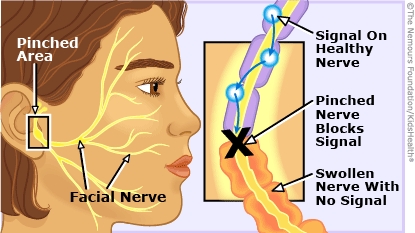Bell's Palsy: How to Care for Your Child
Bell's palsy is a weakness or paralysis on one side of the face that comes on suddenly. It occurs when there is a problem with the facial nerve.


Nerves carry messages between the brain and different parts of the body. The facial nerves carry messages to the muscles of the face, controlling movements like closing the eyes, smiling, or frowning.
In Bell's palsy, the facial nerve swells because it has become inflamed or injured. The swollen nerve gets pinched where it passes through the skull. Messages don't get through the pinched nerve, so the muscles move weakly or not at all. One side of the face may droop and the eyelid may not close completely.
A child may get headaches, have trouble tasting or chewing food, drool from that side of the mouth, feel like sounds are louder in one ear, or have a dry or twitching eye.
In many cases the cause of Bell's palsy is a virus, and it usually gets better without treatment. Symptoms typically come on over 1–2 days and may get worse over several days or weeks before starting to improve.
Sometimes, a health care provider may prescribe medicine to help reduce swelling in the nerve. If the swelling is caused by an infection (such as a herpesvirus infection, an ear infection, or Lyme disease), the health care provider usually prescribes an antiviral drug or antibiotic. If Bell's palsy affects the eye, the health care provider may recommend eyedrops or ointment, an eye patch, or protective glasses.
With or without treatment, the symptoms usually go away in 1–6 months. A few kids continue to have a little facial weakness after they get better.

-
Make sure your child eats well and gets plenty of sleep.
-
Give your child any prescribed medicine or eyedrops as directed by your health care provider.
-
If your child has trouble blinking, he or she should wear protective glasses or an eye patch during sports and other activities.

Your child has:

Bell's palsy can be difficult for kids because it affects their appearance. Reassure your child that his or her face will soon get better. Explaining that it's a medical problem that isn't contagious can be helpful if people ask what's wrong or say unkind things.